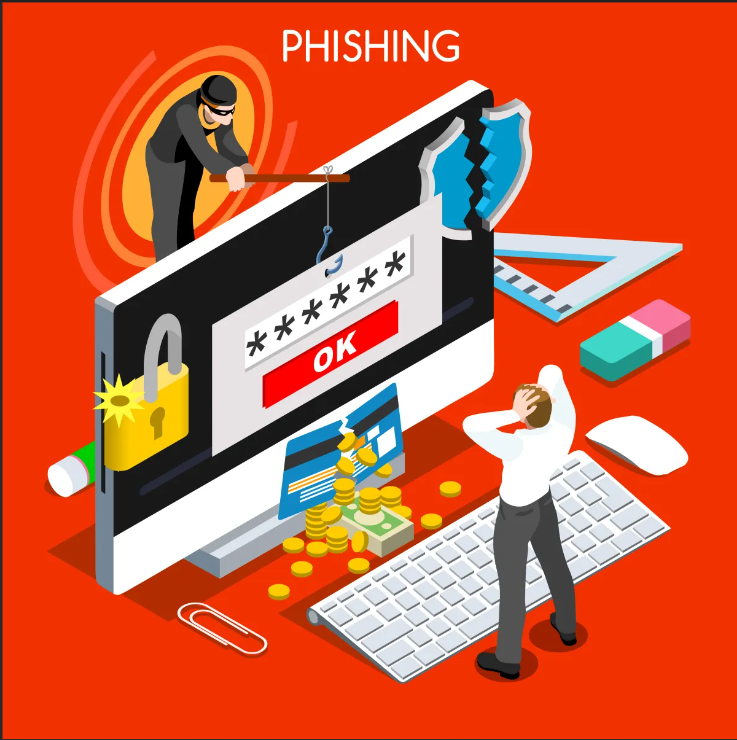
Image source(onlineowls.com)
By Arthur Moses Opio
Introduction
Phishing is a threat that every internet user is familiar with given its prevalence. The term 'phishing' is a slang term that describes the act of tricking an unsuspecting victim into providing sensitive information like passwords and credit card numbers to the attacker. Attackers have gotten more sophisticated over time, making their messages seem legitimate and therefore difficult to distinguish from real ones. Phishing comes in many different forms including emails (email phishing), text messages (smishing), instant messaging (IM phishing) and even phone calls (vishing). In some cases, attackers will try to trick users by sending them links through social media platforms such as Facebook, Instagram or Twitter. As hackers get more clever at devising attacks, it's important for users to be able to identify suspicious behavior quickly without having to second-guess themselves too much."
Phishing (Known Threat)
While phishing has been around for some time, it's not going away anytime soon. In fact, it's one of the most common ways for hackers to gain access to personal information by tricking people into clicking on links or opening attachments in emails they receive from unknown senders.
Phishing isn't new; however, it’s becoming more common because there are more ways than ever before for an attacker to identify you and your online activity (e-mail address, mobile phone number etc.).
Phishing Term
The term 'phishing' is a slang term that describes the act of tricking an unsuspecting victim into providing sensitive information like passwords and credit card numbers to the attacker. It is derived from the word "phishing" (or "phishing" spelled backwards), which means fishing for information.
Phishing can be done through various methods, including email messages, text messages, social media posts and phone calls. In some cases it’s even possible for hackers to use your browser history in order to determine what sites you visit most often—and then send you direct messages on those sites via Facebook or Twitter!
Sophisticated Attacks
Attackers have gotten more sophisticated over time, making their messages seem legitimate and therefore difficult to distinguish from real ones.
The first step in avoiding phishing is to recognize that attackers are trying to trick you into giving them your information. To do this, they use techniques like social engineering and impersonation. Social engineering involves using the trust of those around you—like a friend or family member—to get what you want from them (e.g., their passwords). Impersonation involves pretending to be someone else online; attackers can use this tactic when they want access to personal files or accounts without actually having any credentials themselves
Phishing comes in different forms
Phishing is a form of social engineering that comes in many different forms including emails (email phishing), text messages (smishing), instant messaging (IM phishing) and even phone calls (vishing).
Phishers know how to convince you to do something by impersonating someone you trust. They may send an email claiming to be from your bank or employer and asking for personal information such as your credit card number. Or they might try to trick you into providing access to sensitive files on your computer by sending an email with a link in it that looks like it will take you somewhere safe but actually redirects users directly into the malicious website their attacker designed for them.
Attackers Send Links Through Social Media Platforms
-
In some cases, attackers will try to trick users by sending them links through social media platforms such as Facebook, Instagram or Twitter.
-
If you're not sure if the link is safe, don't click on it.
As hackers get more clever at devising attacks, it's important for users to be able to identify suspicious behavior quickly without having to second-guess themselves too much.
The most effective way to do this is by using your instincts and common sense.
To avoid being phished:
Do not click on links in emails from people you don't know or have never met before (even if they appear authentic). The best way to protect against these types of scams is by staying away from them altogether! If an email seems suspicious, reply with "I'm sorry but I cannot accept your request at this time." This will stop the scammer from sending more messages and possibly tricking other people into responding as well.
How To Avoid Being phished by cybercriminals.
You've probably received emails from your bank or credit card provider in the past that ask for your personal information. These types of emails are very easy to spot, as they will almost always have a legitimate-looking domain name, like "Bankofuganda.com" or "Visa.com."
But what about the ones that don't? They can still be phishing scams and could lead you down a path where your personal information is stolen from one of these companies' databases by cybercriminals who then use it to scam other people out of their money!
Here are some tips on how not to fall victim:
-
Be wary when clicking links within an email—they might lead somewhere unexpected (like another website). If something seems suspicious about where they're going (or if there's no way back), close out any browser tabs/windows immediately before doing anything else online; otherwise, hackers could take over control over them while they're open so they can steal passwords or other sensitive data via man-in-the-middle attacks.
-
Do NOT provide any personal details without verifying with whom I am speaking first.
-
Do NOT provide sensitive financial information over email unless prompted first by someone who knows me well enough--and even then only if I feel comfortable doing so after verifying who this person really is before proceeding further into any conversation.
-
Always double check my answers when filling out forms online because there could be hidden fields where hackers could enter fake responses instead.
-
Use strong passwords whenever possible since this protects against hackers gaining access through cracking passwords stored locally on devices connected directly into networks like computers connecting wirelessly via Wi-Fi signals coming from nearby routers connected inside homes which use wireless modems built into walls around rooms containing electrical outlets located near doors leading outside where sunlight shines brightly onto windows throughout most mornings during summer months (which means less need
Conclusion
As we've seen, phishing is a difficult and persistent problem. The best way to avoid getting hacked is to use good security practices and remain vigilant. However, you can also take what we learned here and make your own modifications if need be!
